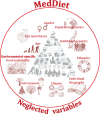Mediterranean diet and inflammaging within the hormesis paradigm
- PMID: 28595318
- PMCID: PMC5914347
- DOI: 10.1093/nutrit/nux013
Mediterranean diet and inflammaging within the hormesis paradigm
Abstract
A coherent set of epidemiological data shows that the Mediterranean diet has beneficial effects capable of preventing a variety of age-related diseases in which low-grade, chronic inflammation/inflammaging plays a major role, but the underpinning mechanism(s) is/are still unclear. It is suggested here that the Mediterranean diet can be conceptualized as a form of chronic hormetic stress, similar to what has been proposed regarding calorie restriction, the most thoroughly studied nutritional intervention. Data on the presence in key Mediterranean foods of a variety of compounds capable of exerting hormetic effects are summarized, and the mechanistic role of the nuclear factor erythroid 2 pathway is highlighted. Within this conceptual framework, particular attention has been devoted to the neurohormetic and neuroprotective properties of the Mediterranean diet, as well as to its ability to maintain an optimal balance between pro- and anti-inflammaging. Finally, the European Commission-funded project NU-AGE is discussed because it addresses a number of variables not commonly taken into consideration, such as age, sex, and ethnicity/genetics, that can modulate the hormetic effect of the Mediterranean diet.
Keywords: Mediterranean diet; Nrf2; hormesis; inflammaging; stress.
© The Author(s) 2017. Published by Oxford University Press on behalf of the International Life Sciences Institute.
Figures




Similar articles
-
Combating inflammaging through a Mediterranean whole diet approach: the NU-AGE project's conceptual framework and design.Mech Ageing Dev. 2014 Mar-Apr;136-137:3-13. doi: 10.1016/j.mad.2013.12.001. Epub 2013 Dec 14. Mech Ageing Dev. 2014. PMID: 24342354
-
Inflammaging and cancer: a challenge for the Mediterranean diet.Nutrients. 2015 Apr 9;7(4):2589-621. doi: 10.3390/nu7042589. Nutrients. 2015. PMID: 25859884 Free PMC article. Review.
-
Healthy ageing and Mediterranean diet: A focus on hormetic phytochemicals.Mech Ageing Dev. 2021 Dec;200:111592. doi: 10.1016/j.mad.2021.111592. Epub 2021 Oct 25. Mech Ageing Dev. 2021. PMID: 34710375
-
The phytoprotective agent sulforaphane prevents inflammatory degenerative diseases and age-related pathologies via Nrf2-mediated hormesis.Pharmacol Res. 2021 Jan;163:105283. doi: 10.1016/j.phrs.2020.105283. Epub 2020 Nov 4. Pharmacol Res. 2021. PMID: 33160067 Review.
-
The role of nutrition in inflammaging.Ageing Res Rev. 2022 May;77:101596. doi: 10.1016/j.arr.2022.101596. Epub 2022 Feb 24. Ageing Res Rev. 2022. PMID: 35219904 Review.
Cited by
-
Dietary Risk Factors and Eating Behaviors in Peripheral Arterial Disease (PAD).Int J Mol Sci. 2022 Sep 16;23(18):10814. doi: 10.3390/ijms231810814. Int J Mol Sci. 2022. PMID: 36142725 Free PMC article. Review.
-
Failure to Thrive in the Outpatient Clinic: A New Insight.Nutrients. 2020 Jul 24;12(8):2202. doi: 10.3390/nu12082202. Nutrients. 2020. PMID: 32722001 Free PMC article. Review.
-
Could "cellular exercise" be the missing ingredient in a healthy life? Diets, caloric restriction, and exercise-induced hormesis.Nutrition. 2022 Jul-Aug;99-100:111629. doi: 10.1016/j.nut.2022.111629. Epub 2022 Feb 7. Nutrition. 2022. PMID: 35489165 Free PMC article. Review.
-
Mitigation of Insulin Resistance by Natural Products from a New Class of Molecules, Membrane-Active Immunomodulators.Pharmaceuticals (Basel). 2023 Jun 21;16(7):913. doi: 10.3390/ph16070913. Pharmaceuticals (Basel). 2023. PMID: 37513825 Free PMC article. Review.
-
Oxidative Stress in Type 2 Diabetes: Impacts from Pathogenesis to Lifestyle Modifications.Curr Issues Mol Biol. 2023 Aug 12;45(8):6651-6666. doi: 10.3390/cimb45080420. Curr Issues Mol Biol. 2023. PMID: 37623239 Free PMC article. Review.
References
-
- Selye H. The Stress of Life. New York: McGraw-Hill Book Co; 1978.
-
- Ottaviani E, Franceschi C. The neuroimmunology of stress from invertebrates to man. Prog Neurobiol. 1996;48:421–440. - PubMed
-
- Ottaviani E, Franchini A, Franceschi C. Pro-opiomelanocortin-derived peptides, cytokines, and nitric oxide in immune responses and stress: an evolutionary approach. Int Rev Cytol. 1997;170:79–141. - PubMed
-
- Ottaviani E, Franceschi C. A new theory on the common evolutionary origin of natural immunity, inflammation and stress response: the invertebrate phagocytic immunocyte as an eye-witness. Domest Anim Endocrinol. 1998;15:291–296. - PubMed
-
- Ottaviani E, Malagoli D, Capri M et al. . Ecoimmunology: is there any room for the neuroendocrine system? Bioessays. 2008;30:868–874. - PubMed
Publication types
MeSH terms
Substances
LinkOut - more resources
Full Text Sources
Other Literature Sources
Medical
Research Materials

